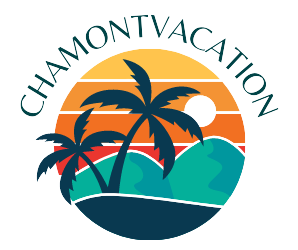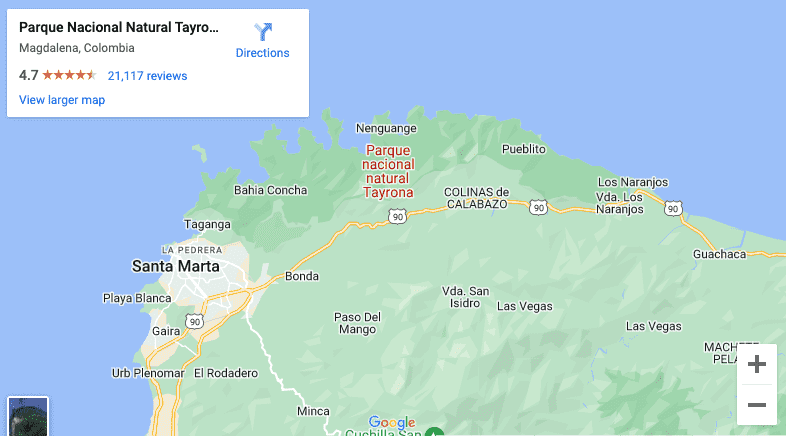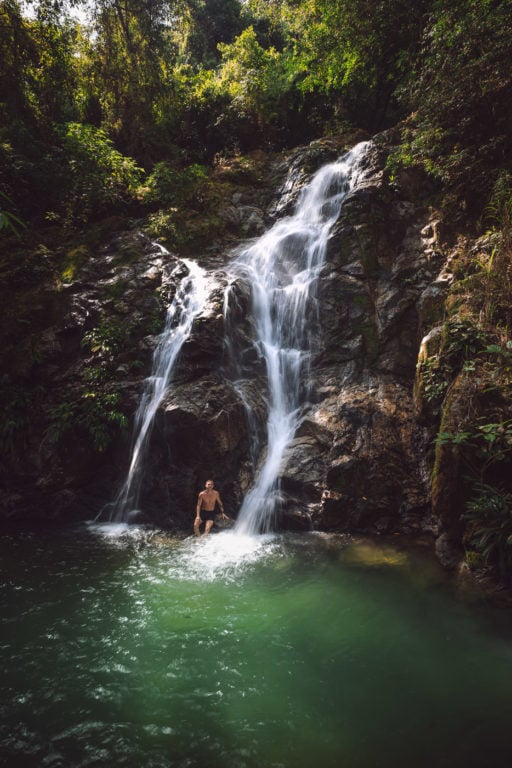Wondering how to get to Tayrona National Park? Find out the best options below!
There are so many fun things to do in Tayrona National Park, from spotting rare animals like the cotton-top Tamarin to swimming on white, sandy beaches like Cabo San Juan.
However, the first thing you need to know is exactly how to get here! In this guide, I’ll break down all the options based on my experience traveling in the region and the advice of locals at my homestay!
Where is Tayrona National Park in Colombia?
Tayrona National Park, or Parque Nacional Natural Tayrona in Spanish, is a 150 km² (60 mi²) protected area located in the Magdalena department on the northern Caribbean Coast of Colombia.
This coastal strip of tropical jungle, coral reefs, and pristine beaches is tucked between the sea and the Sierra Nevada mountains and accessible via Highway 90 (Troncal del Caribe).
The closest city to Tayrona Park is Santa Marta, which is approximately 37 kilometers away (from the main entrance of El Zaino).

The 2 Park Entrances to Tayrona National Park
This park is quite large. So, in order to know how to get to Tayrona National Park, it's important to consider that there are actually two different entrances, each accommodating a different area of the park.
These are:
- El Zaino - the main entrance and best access point to Cabo San Juan Beach
- Calabazo - the secondary entrance providing the best access to Playa Brava Beach
The entrance fee (currently 62,000 COP), is the same at both gates, and you can pay this in cash or with a credit card. This increases to 73,500 COP during the peak season (December through to January) and public holidays.
Both entrances are located along the same road, with Calabazo being the closest to the city of Santa Marta. Below I'll go into more detail on how to get here.

How to Get to Tayrona National Park
To get to Tayrona National Park, it's best to first make your way to Santa Marta. Santa Marta has its own airport, and a popular bus transport hub connecting other cities in Colombia.
Once you make your way to Santa Marta, you'll have two main options to get to either entrance gate of Parque Tayrona.

Option 1: Day Trip To Cabo San Juan Tayrona
If you're short on time, in a group of travelers, or perhaps simply just want the most convenient way to experience the best of Tayrona National Park on a day trip, then a private tour might be the best option for you.
There is one day trip that you can book online that includes return transport from Santa Marta, Taganga, Rodadero, Pozos Colorados, or Bello Horizonte. This day trip option includes a hiking guide through the park and all the way to Cabo San Juan Beach.
This is great value as all park admission fees (notoriously expensive) are included in the cost as well. Furthermore, you won't have to line up in long lines at the park entrance.
View more: Full-day Tayrona Park Excursion With Guide

Option 2: Independent Travel Using Public Transport
If you want to visit this National Park independently, then you can take either of the following public transport options:
- Cheap public bus from Santa Marta Mercado - best if you're already in Santa Marta or coming on the Colectivo from Palomino or Minca
- Coach bus from Santa Marta Bus Terminal - best if you're already coming into Santa Marta Bus Station on a coach from another Colombian city
- Taxi or private transport - a little expensive at around 80,000 Colombian pesos but can be cost-effective if shared
Cheap Public Bus to the El Zaino Entrance
The best way (also the cheapest) to get to the El Zaino Entrance is to take the local green bus running from the Santa Marta Public Market (Mercado Público de Santa Marta).
This bus runs every 30 minutes or so, starting from 8:00 AM, and costs just 8,000 Colombian Pesos. Expect a journey of just over an hour from Santa Marta before stopping at a parking lot just outside the park.
When you're at Mercado Santa Marta, just ask any local for "Tayrona" and they'll point to the bus you need.
If you're coming from Minca, the colectivo takes you directly to the public market, where you hop off directly next to the Tayrona bus.

Coach Bus From Santa Marta Bus Station
For travelers looking to get to Tayrona National Park from other parts of Colombia like Cartagena or Medellín, you also have the option to take a more expensive, but much more comfortable coach bus to the entrance.
This is a convenient option if you end up at the Santa Marta Bus Station (Terminal de Transportes de Santa Marta), which is approximately 20 minutes outside the actual city. However, if you're already in Santa Marta, or if you're coming from Minca or Palomino, this wouldn't make much sense.
For the rest of you, the best and safest bus company is called Brasilia, and you can book all your tickets in advance using the convenient Busbud website.

Arriving at El Zaino Tayrona National Park Entrance
Once you arrive at the El Zaino entrance, you'll undoubtedly be greeted by several salespeople offering you accommodation in the park. If you're looking to camp, then it's easiest to just pay the camping fee here (since it's the same price inside the park anyway).
Afterward, travelers will also need to pay the Taryona National Park entrance fee, which is currently 62,000 COP per person (seems to increase every year). Note that this currently increases to 73,500 COP in high season, starting in December through to January and public holidays.
Additionally, it is now a requirement to pay for Tayrona medical insurance at the entrance as well, which is 5,000 pesos per day. You can pay both of these fees with your credit card
Tip: There are no ATMs within the national park. So, make sure you bring enough cash with you to last the duration of the trip.
If you want to stock up on fruit, food, or water, you can do so just outside the entrance. Here, you'll also find a few local restaurants to grab a bite to eat as well.

Once you're finally inside Tayrona Park, you'll see a bunch of shared colectivo vans just past the entrance. These guys run back-and-forth transport trips to the end of this main road for 5,000 pesos.
Tip: for the best chance of spotting wildlife, including the very rare cotton-top tamarin, then you should know that this main road is actually the best place to do so! While most tourists take the colectivo, I was told this in advance, and this is where I spotted most of the monkeys, sloths, birds, and other animals you see in my photos on this blog.

Where to Stay in Tayrona National Park Once You Arrive
Most backpackers will tell you that you only need one or two nights of camping at Cabo San Juan Beach. However, I recommend spending at least a night in the jungle interior as well.
This will give you the best of both worlds, waking up to a beautiful sunrise over turquoise waters AND spending the night in the forest amongst rare and protected wildlife!
You don't need to book your camping in advance but I highly recommend booking accommodation in Tayrona National Park online as there aren't many options available. Here are my recommendations.

1. Ecohabs Bamboo Eco
Beautiful Ecohabs (bamboo cabins) nestled in the deep jungles and surrounded by wildlife.

2. Mirador del Parque Budget
Budget option for staying inside Tayrona National park. Sleep in dorms or private jungle huts high on a hill overlooking the jungle canopy.

3. Ecolodge Playa Brava Beach Huts
Amazing beach huts located right on Playa Brava beach.
Tip: While you can also stay outside the entrance, it's worth booking accommodation inside the park since otherwise, you'll need to pay for multiple entrance tickets (which are expensive).

Quick Things to Know About Tayrona National Park
- Tayrona National Park is closed starting February 15th for the remainder of the month.
- You can pay for your entrance ticket at the gate - you also need your passport at the entrance
- It's best to bring your own drinking water - I swear by my Grayl Purifier bottle and haven't purchased a plastic water bottle since buying it three years ago!
- Plastic bags are banned in Tayrona - don't bring any in
- There are no ATMs - bring enough cash
- You can camp on the beach or stay in cabañas - I have loads of recommendations below
- You can't swim at many of the beaches - strong currents and waves have resulted in many drownings in this park
- Tayrona NP Travel insurance is compulsory - limited insurance is compulsory for 5,000 COP per day at the entrance.
- If you're camping, don't bring large backpacks - instead, leave them at your accommodation (Masaya Hostel in Santa Marta & Dreamer Hostel in Palomino allow you to do this).
- Tayrona Park gets busy in high season - it's busiest in December & January and on weekends & public holidays
More Colombia Travel & Adventure Blogs
I hope that you've found this quick guide on how to reach Tayrona National Park from Santa Marta or nearby towns like Minca and Palomino helpful in planning your adventures.
If you have any updates or different route suggestions, let me know in the comments and I'll update this post!
Otherwise, check out some more Colombia travel inspiration below!
- Medellín Travel Guide: Discover fun activities and top highlights in Medellín
- San Andrés Island: Guide to Colombia's best Caribbean Island
- Minca Travel Guide: Discover incredible hikes, beautiful fincas, epic jungle waterfalls, and all-around relaxing vibes.
- Things to do in Guatapé: Travel to Colombia's most scenic Antioquian town, known for its vibrant streets, traditional street art and the famous Piedra del Peñol.
- Accommodation Guides:


